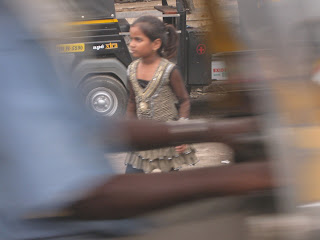Thursday (November 11) we began the Golden Triangle Tour from Delhi to Agra to Jaipur to Delhi. We got a later start than we wanted (9 am instead of 7 am) but that probably didn't affect the amount of traffic in any way. India has 1.2 billion people. At least 1.1 billion of these must be in the wrong place since they seem to be going somewhere on the roads.

We encountered every type of conveyance imaginable: walking, bicycle, motorized bicycle, motorcycle, rickshaw, auto-rickshaw (in some countries called the tuk-tuk), autos, trucks, tractors, busses, carts pushed by a man, and carts pulled by a man, a horse, one or two oxen, or a camel. All of these mix together in an amazingly effective (and inevitably inefficient) chaos.

The most common vehicles are the bicycle, motorcycle, and auto-rickshaw, and these slip through traffic using whatever tiny spaces are left by the larger vehicles. The observed capacity of a bicycle or motorcycle is four people, with the larger load including one or two children. A typical load is husband, wife, and one or two children. The auto-rickshaw, on the other hand, can hold 16 people, as we observed. (Later we saw this capacity increased as 3 or 4 men road standing up on the outside of the vehicle.)
 |
| Auto-Rickshaws |
What is an auto-rickshaw, you ask. Imagine a motorcycle with two back wheels, enclosed in a metal body. The front and back seats are bench seats. The driver sits on the right hand side. In this configuration, it "comfortably" seats 4 or 5 people: the driver, a front-seat passenger, and 2 or 3 people in the back seat, all facing forward. Now imagine that the front and back seats are modified to be wider from front to back, and the back end of the vehicle is removed (the hatch of the hatchback is removed). Place 4 people in the front seat facing forward. Place 4 people on the back of the front seat, facing backward (with their backs to the previously mentioned front seat passengers and driver). Repeat this configuration with the back seat, resulting in 4 more passengers facing forward and 4 facing out the back of the vehicle. Voilà - 16 people! The auto-rickshaw is the workhorse of the road for transporting people and anything else imaginable.
Before coming to India, we read that the yielding order of vehicles (ordered from most yielding to least yielding) is people, bicycles, rickshaws, cars, trucks, busses, cows. A better way to understand this ordering is to think of it as an audacity order (most audacious to least), except that cows are the very most audacious.
After observing traffic behavior since arriving in India, the rules of the road seem to be these:
1. There are no rules.
2. Lane markings, as well as direction of travel, are suggestions only, even on divided highways.
3. The horn is the most important equipment for navigation, announcing "Here I am - move out of my way."
Once when our driver was passed at a stoplight by a motorcycle he said "Why did he do that? He knows the rules!" All we could think was "Rules????" Many cars were missing side mirrors. It is unclear why any of the others still have them.
Each motorized vehicle has a horn that beeps, toots, trills, or warbles, and each horn sound is as unique and individual as cellphone ring tones. Together, they create a cacophony of sound somewhat like an orchestra of only the horn instruments warming up, neither unpleasant nor cohesive. The backs of trucks generally request "Honk Please." (This may be considered an alternate form of the signs on the backs of trucks at home that state "If you can't see my mirror, then I can't see you.) It made us wonder if any hand gestures considered impolite at home are considered friendly greetings here.
The roads we took between Delhi and Agra are in various states of disrepair, ranging from merely potholed to a washboard of crumbling concrete and dirt. Luckily, we are beyond the monsoon season, or mud would also add to the problem. Some of the highway we encountered was fairly new, which meant that the "rules of the road" (see above) were executed at a much faster pace! Just as at home, we made our very slowest progress in areas where road construction was under way. (To give an idea of just how slow construction appears to be, we saw a large family making itself at home underneath a bridge being constructed, using a pile of construction sand as a huge bed. Meanwhile, atop a flimsy ladder, the lone road worker dabbed beige paint at the top of one huge bridge support.)
Other exotic animals that we saw on the way (thankfully not used for transportation) were monkeys and an elephant. We did see a monkey sitting on the seat of a bicycle being peddled by a man who was standing up as he peddled. It wasn't clear who was the boss.
 |
| Laundry vs. Monkey |
Entering Agra, just hundreds of meters from the sleeping family, we saw a colony of monkeys freely using an ancient mostly-uninhabited building. The only occupied part was a residence on the top floor overlooking the new bridge, with a balcony hung full of laundry guarded by a woman. The colorful fabric was undoubtedly attractive to the monkey perched just above her.


































